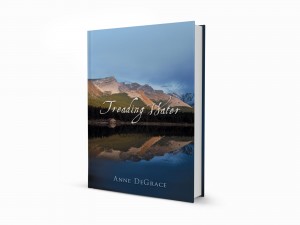Treading Water
Books
 The voices of the residents of Bear Creek surface in Treading Water, a novel in twelve stories. Gus Sanders, a young trapper, arrives to seek his fortune in 1904, but loses his heart, and then his life; Jake Schroeder must choose between his wartime desire to join up and his Mennonite pacifist roots; Isobel Grey, suffragette, escapes the Winnipeg protests and brings her politics with her; Dutch war bride Aliesje Milner, six months pregnant, waits at the train station for a husband whose face she can no longer remember; and young Paul Doyle’s summer job demolishing houses to make way for the new hydroelectric dam teaches him more than he bargained for. The indomitable personality of Ursula Hartmann, first child born in Bear Creek and among the last residents to leave, threads through the chapters as they trace a community from its hopeful beginnings until the day the waters rise.
The voices of the residents of Bear Creek surface in Treading Water, a novel in twelve stories. Gus Sanders, a young trapper, arrives to seek his fortune in 1904, but loses his heart, and then his life; Jake Schroeder must choose between his wartime desire to join up and his Mennonite pacifist roots; Isobel Grey, suffragette, escapes the Winnipeg protests and brings her politics with her; Dutch war bride Aliesje Milner, six months pregnant, waits at the train station for a husband whose face she can no longer remember; and young Paul Doyle’s summer job demolishing houses to make way for the new hydroelectric dam teaches him more than he bargained for. The indomitable personality of Ursula Hartmann, first child born in Bear Creek and among the last residents to leave, threads through the chapters as they trace a community from its hopeful beginnings until the day the waters rise.
Reviews
The writing is clear as a bell, the language crisp and clean, the stories often very moving. This a remarkable debut. Read more >>
…an immensely readable and realistic novel. Read more>>
Excerpts
Chapter 1
The axe lies against the chopping block to his left. There is no question: wood is required. He chooses not to think, but instead seizes the axe in a swift movement, the familiar shape fitting reassuringly into his palm. In a moment there is wood on block, axe in air, pieces on ground. But there is the slicing pain on the downswing, as if he has cut off his own foot with the axe, and with the biting shift of weight from foot to foot, the sharpness of the day rises, then falls. Read more>>
Chapter 12
When I got the job holding the hose for the house burnings I figured: hey, it’s a job. It’s not like anything I could say or do will make any difference to this backwater called Bear Creek. It’s all going to be under water—35 feet of water—in a few months’ time, and by then we’ll all be long gone. Read more>>
Audio interview
Sheryl McKay of CBC Radio’s NXNW interviews Anne. Listen to Mp3
Book Club Questions
1. 1904: The first chapter closes with the death of its principle character. Did this surprise you? Why do you think the author did this?
2. 1905: Three women come together for the birth of Ursula: Justine, Birthe, and of course, Frieda. How does Justine’s cultural background help or hinder the situation? What common sensibilities do they all share with regard to babies and husbands?
3. 1915: Jake is also caught in a cultural dilemma. What might his father have said when they received notification of his death? His mother? How might the community have responded?
4. 1919: How does Isobel’s past work with the suffragette movement affect how she sees the world? Why might an animal bridge differences?
5. 1921: What other authors have used shell-shock (post traumatic stress disorder) as a basis for works in fiction or nonfiction? Little was known about the disorder at the time of the First World War. What is known today?
6. 1932: This chapter, although set in a particular place and time, could easily happen in a different place or time. What themes make this story universal in nature?
7. 1936: Two parallel characters—Duncan and Ursula—never find a point of connection as their perceptions of the situation are completely different. Has this ever happened to you?
8. 1946: War brides were courageous. In their home countries, some also said they were foolish, knowing little of the place they were going or even the men they married. What stories of war brides do you know and can share?
9. 1950: How is the flood a metaphor for loss and grief? What resolution is suggested by the way the chapter ends?
10. 1954: By the end of the chapter, Ellie has gone too far to turn back. Discuss the contributing factors to her choice. Does Tom accept it?
11. 1965: Land expropriation for dam development has affected people all over the world. Is the displacement of a few to provide hydroelectricity to many inevitable? Is it right?
12. 1967: Some residents can only look forward when crossing on the ferry for the last time. Others look back. Which would you be? Why?
13. The author has structured this book as a novel told in twelve separate stories. What do you think of this structure? Some characters show up again and again, while other do not. Which characters would you like to know more about?
